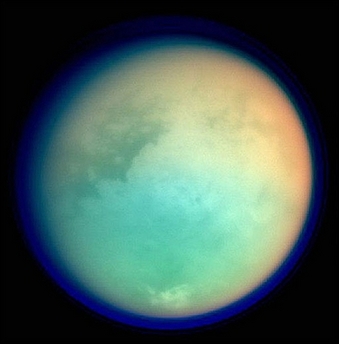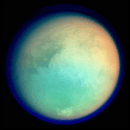 |
|---|
| AFP/NASA-HO/File NASA |
 
|
Saturn's Moon Titan a Frozen World
AP
February 19, 2005
WASHINGTON - Data from the Cassini-Huygens spacecraft suggest that Titan, a moon of Saturn, is a world with the potential of life that was frozen in its youth, prevented by deep cold from ever developing into a livelier place.
"Titan is the Peter Pan of our solar system. It's a little world that never grew up," said Tobias Owen of the University of Hawaii, a member of an international team monitoring the findings of the Huygens spacecraft sitting on Titan's surface.
The minus 290 degree F temperature of Titan prevented the chemical reactions that are thought to have occurred on Earth, possibly leading to the evolution of life, said Owen, one of a group of researchers presenting papers on Titan at the national meeting of the American Association for the Advancement of Science.
"All of the elements that we are made of are there," Owen said Friday, "but all of the water is frozen solid. There's no oxygen available. If it could warm up, it would be beautiful."
Ice appears to form the bedrock of Titan, he said, and there is some suggestion of cryovolcanoes, volcanic-like vents that spew forth ice instead of lava. Owen said features detected by the Cassini spacecraft, orbiting Titan, show channels resembling volcanic features on Earth, but they may have been carved by creeping ice, not molten rock.
Owen said the evidence for ice volcanoes on Titan is "shaky," but it is the leading theory to explain some of the features seen on the body.
"We're not expecting to find life on Titan. It's just too cold," said Owen. "But we expect to find the primordial ice cream" - the complex of chemicals that could possibly be the precursors to life.
Cassini-Huygens is a joint NASA-European Space Agency project. The combined craft was launched in 1997 and arrived in orbit of Saturn last year. Huygens, a lander developed and controlled by the ESA, touched down earlier this year.
Early studies show Titan is covered with pools of methane, an organic chemical maintained on the surface by deep cold.
Owen said that Huygens apparently landed in a "mud" formed by methane and that heat from the craft created a cloud of the gas that instruments quickly analyzed and identified.
Titan's intense cold and atmospheric pressure - about 1 1/2 times that of Earth - keep methane in a liquid state. Researchers earlier said there are methane showers on Titan and a methane fog.
Methane is a highly flammable gas, but there is no free oxygen on the moon to support combustion. Instead, methane flows and showers and pools.
"Methane takes the role that water does on Earth," said Owen. "And ice is like sand." He said in Titan's intense cold, chips of ground ice could be like beach sand, drifting with the flow of methane.
Dennis Matson of NASA's Jet Propulsion Laboratory said that ice forms the bedrock of Titan and that sometime during the formation of the moon the frozen water may have warmed enough to flow to the surface like lava in a volcano on Earth.
"It would be the consistency of magma. At some temperatures below freezing, ice is pliable," he said. "It could flow like toothpaste out of a tube."
Matson emphasized that the ice volcano concept is still a theory, but it offers the best explanation for some features seen on the surface of Titan.
Scientists at the conference also reported on the progress of Spirit and Opportunity, two rolling robots that have been exploring the surface of Mars for more than a year.
Steven W. Squyres of Cornell University, one of the principal scientists on the Martian rover mission, said Spirit took a self-portrait with one of its cameras that shows the craft's solar power panels coated with a reddish grime. This cuts down on the amount of sunlight the craft can use to make electrical power.
"It is so dirty that it is important that we always orient it toward the sun," said Squyres. "We are slaves to the sun."
A self-portrait by Opportunity shows that its solar panels are clean, "like it's just off the showroom floor," Squyres said.
Spirit, which is slowly exploring the north flank of a Martian hill named Husband, has found bedrock sticking out of the red soil. It also churned up surface soil, and pictures sent to Earth show a layer of "bright stuff" that Squyres said is probably a type of sulfur salt.
The rover also photographed layers of fragile-appearing light rock that researchers believe is basaltic sand glued together with a magnesium-sulphur salt. Such a process could occur in a pool of water, said Squyres. Earlier studies have shown that liquid water once flowed in great quantities on Mars, but the planet's surface is now very dry.


 Share your thoughts in the Forum
Share your thoughts in the Forum
